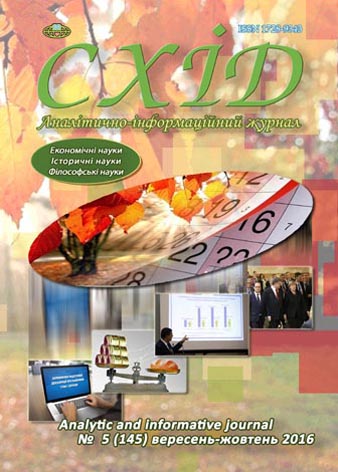Analysis of the relationship degree of integration with the growth of welfare in the countries - members EU, NAFTA, ASEAN, MERCOSUR
DOI:
https://doi.org/10.21847/1728-9343.2016.5(145).82934Keywords:
free-trade zone, Customs Union, economic union, regional integration, integration associations, gross domestic product, income levels, NAFTA, EU, ASEAN, MERCOSURAbstract
Modern world economy includes more than one hundred regional trade agreements in place and number that is continuously evolving. Recently some countries reconfigure their economic and political interests and priorities to protectionism. From another side, the expansion of the World Trade Organization has created side agreements with other regional groups leading to a web of trade agreements and understandings.
The article is considered the features of integration agreements on the example of the EU, NAFTA, ASEAN and Mercosur. The influence of the process of international economic integration on the gross domestic product, employment and incomes of participating countries is examined. It defines dependence of the effects of integration on stages of integration and economic development of members' countries.
It is determined that regional integration is changing welfare of population on macro and micro levels. It is defined the degree of integration depends upon the willingness and commitment of independent sovereign states to share their sovereignty. Deep integration that focuses on regulating the business environment in a more general sense is faced with many difficulties.Downloads
References
Balassa, B. (1994), The theory of Economic Integration: An Introduction, in: The European Union. Part 2, Macmillan Education UK, 125-137. doi: 10.1007/978-1-349-23984-9_15
Viner, J. (2014), The Customs Union Issue, Oxford University Press, Oxford; New York, 198 p. doi: 10.1093/acprof:osobl/9780199756124.001.0001
Ching, Stephen and Devereux, Michael B. (2000), Risk Sharing and the Theory of Optimal Currency Areas: A Re-Examination of Mundell 1973, HKIMR Working Papers, No. 8/2000. doi: 10.2139/ssrn.1009489
Filipenko, A. S. (2007), Global forms of Economic Development: History and Modernity, Znannia, Kyiv, 670 p. (ukr).
Puzanov, І. I. (2002), Formation of the Terms of Trade of Ukraine, Publishing Center «Kyiv University», Kyiv, 367 p. (ukr).
Shnyrkov, O. I. (2005), Trade Policy of the EU, Publishing Center «Kyiv University», Kyiv, 152 p. (ukr).
Burakovsky, I. and Khandrikh, L. and Hoffmann, L. (2003), Ukraine’s WTO Accession: Challenge for Domestic Economic Reforms, Kyiv, 290 p. (ukr).
Samosonok, L. M. (2012), Dynamics of population income and employment in country-members of regional integration blocs, Aktualni problemy ekonomiky [Actual Problems of Economics], № 10 (136), 15-20 (ukr).
Fedirko, N. and Konstantinova, A. (2015), Macroeconomic effects of international regional economic integration: Global practice and challenges for Ukraine, Mizhnarodna ekonomichna polityka [International economic policy], № 1 (22), 155-179 (ukr).
Cherep, A. V. and Pavlenko, N. V. (2012), Theoretical foundations of economic integration, Ekonomichnyi Prostir, № 68, 16-28 (ukr).
Makarenko, T. E. (2012), Asymmetric development of integration associations in a global transformation, Ekonomichnyi chasopys [Economic Annals-XXI], № 7-8, 16-18 (ukr).
Information website «World Economy», available at: http://www.ereport.ru/ (rus).
Official website of the World Bank, available at: http://data.worldbank.org/indicator/ny.gdp.pcap.cd (engl).
Official website of the International Labour Organization, available at: http://www.ilo.org/global/lang—en/index.htm (engl).
Information website «Centre of Humanitarian Technologies», available at: http://gtmarket.ru/ratings/human-development-index/human-development-index-info (rus).
Official website of MERCOSUR, available at: http://www.mercosur.int/ (esp).
Information website NAFTA member countries, available at: http://www.naftanow.org/results/default_en.asp (engl).
Downloads
Published
How to Cite
Issue
Section
License
Copyright (c) 2016 Grygoriy Shamborovskyi

This work is licensed under a Creative Commons Attribution-NonCommercial-NoDerivatives 4.0 International License.
1. Authors bear responsibility for the accuracy of facts, quotations, numbers and names used.
2. Manuscripts are not sent back.
3. The publisher does not always agree with the authors' opinion.
4. The authors reserve the right to authorship of the work and pass the first publication right of this work to the journal under the terms of a Creative Commons Attribution-NonCommercial-NoDerivatives 4.0 International License. This license allows others to distribute (copy) the published work for non-commercial purposes, provided there is mandatory attribution to its authors and a link to the first publication in our journal.
5. The authors have the right to conclude separate supplement agreements that relate to non-exclusive work distribution in the form in which it has been published by the journal (for example, to upload the work to the online storage of the journal or publish it as part of a monograph), provided that the reference to the first publication of the work in this journal is included.

